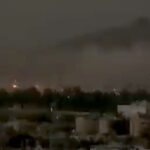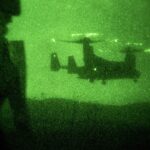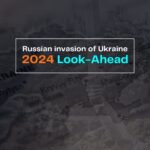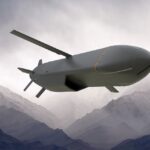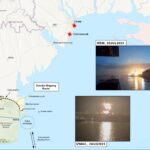The British Royal Air Force (RAF) Quick Reaction Alert-North (QRA) from Lossiemouth scrambled three times in the past week to intercept Russian military aircraft transiting the United Kingdom’s flight information region (FIR). The British QRAs, often done in partnership with regional allies, are coordinated by the Combined Air Operations Centre (COAC) based in Uedem, Germany. COAC-Uedem acts as NATO‘s Command and Control hub for the northern air policing area.
During their transits through the UK’s FIR, the Russian aircraft buzzed the flight corridors used by civilian airliners to enter and depart British airspace. The RAF jets, typically two or three Eurofighter Typhoons, activated their transponders to make themselves visible to air traffic controllers (ACT) while shadowing the Russian “visitors.” This allowed the ACT authorities to see where the uncooperating planes are and de-conflict the airspace accordingly. At times ACT had to divert commercial flights to mitigate the risk of collision with the “incognito” Russian aerial formation.
For those wondering why the RAF shadowed Russian aircraft in international airspace west of Ireland yesterday, their routing cut straight across the routes taken by airliners crossing the North Atlantic (and the TU-142MR trails an antenna several kms long when talking to subs). pic.twitter.com/3QKx3ltT0W
— Andy Netherwood (@AndyNetherwood) March 8, 2020
Russian military activity in the Greenland-Iceland-UK (GIUK) gap has increased exponentially in the past years in terms of training exercises, anti-submarine warfare (ASW) sorties and maritime surveillance missions. The GIUK gap is very important for Russia to move its nuclear-capable submarines and ASW aircraft in and out of the North Atlantic in case of war. To better understand the enemy order of battle and tactics in the region, the Russian are deliberately testing the RAF and NATO’s overall QRA reaction (time and tactics) while also monitoring maritime movements.
FIRST INTERCEPTION
The first interception this week took place on 8 March 2020, when a composite formation of Russian Aerospace Forces (RuAF) and Russian Navy (RuN) buzzed both the Norwegian and the British FIRs. The Russian composite formation consisted of one Tu-142 MK ASW and maritime patrol aircraft (AISC/NATO Reporting name: Bear-F), one Tu-142MR/M submarine communications relay variant (Bear-J), and one MiG-31 (Foxhound) operated by the RuAF.
The Royal Norwegian Air Force (RNoAF) scrambled first and deployed two F-16AM fighter jets, which conducted an initial visual identification of the Russian aircraft formation, and (for the first time) two F-35A stealth multirole fighters. When the two Bear’s continued their flight further down over the North Sea, two RAF Eurofighter Typhoons intercepted them.
The Tu-142s are the maritime variant of the notorious Tu-95 strategic bombers and were built to hunt NATO submarines. The Russians were likely collecting intelligence on the NATO naval buildup in Norway for the multinational exercise “Cold Response” as well as communicating with submerged platforms.
SECOND INTERCEPTION
RAF Lossiemouth dispatched two QRA Typhoons to intercept and shadow two Russian Tu-142 (Bear-F) aircraft as they approached the UK’s area of interest on 11 March 2020. The British Typhoons intercepted the Russian “Bears” west of the Shetland islands, inside the UK’s FIR, and shadowed them south towards Ireland. French aircraft took over QRA duty for the airspace until the Bay of Biscay, where the Bears returned north and were again intercepted by the RAF jets.
Early this morning, #TeamLossie launched two Quick Reaction Alert Typhoons to intercept and shadow two Russian Tu-142 Bear-F aircraft as they approached the UK’s area of interest.
This thread is everything you need to know 👇
1/7 #QRA pic.twitter.com/YuzWxcLtma
— RAF Lossiemouth (@RAFLossiemouth) March 11, 2020
THIRD INTERCEPTION
RAF Lossiemouth scrambled three QRA Typhoons to intercept and shadow two Russian Tu-160 long-range strategic bombers (“Blackjack”) on 12 March 2020. The flight path and pattern was identical to the one from the day before.
Following the QRA launches we’ve had this week from @RAFLossiemouth alongside our NATO allies @Armee_de_lair to intercept Russian aircraft here is some footage from inside RAF Typhoons. #WeAreNATO #SecuringTheSkies pic.twitter.com/G9wkImvj21
— Royal Air Force (@RoyalAirForce) March 12, 2020
SECURING THE SKIES TRANSPARENTLY
The RAF Lossiemouth QRA team proved that it can secure British and NATO skies at a moment’s notice 24/7 and 365 days per year. However, thanks to its social media and communications team, RAF Lossiemouth demonstrated how a military operation can be done efficiently and transparently.
The RAF Lossiemouth has actively engaged with the public through its Facebook and Twitter accounts, explaining why and how the interceptions were conducted, sharing photos from the QRA scrambles and even publishing ADS-B/ Mode-S tracking codes so that enthusiasts can track their aircraft using flight trackers.
- Russia Bombs Maternity Ward & Children’s Hospital in Mariupol As Part of Siege - 10 March 2022
- T-Intell’s OSINT Training Marks One Year Anniversary - 18 November 2021
- IS-K Never Left the Battlefield - 27 August 2021



